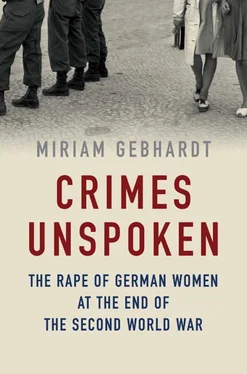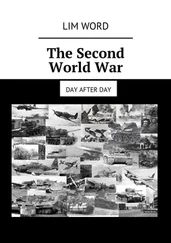And then he asked me: ‘Which one did it?’
I looked at them, all seven or eight, and thought: ‘Now’s your chance to get your own back – for all the pain, for the mortal fear, for these humiliations and the stigma.’ That was my first thought. My second thought was: ‘Eva, pull yourself together. They are also human. They are the Russians you have been waiting for.’ I looked from one to the other, recognized them all, including the small fat one who had been particularly mean. I looked them all in the eyes, and in their eyes I saw only one thing: fear. I said to myself: ‘It’s not worth it for even a single life to be lost on your account and on account of the disgrace they’ve brought upon you.’
Eva Ebner in her recollection of the line-up of the Red Army soldiers
[1] Eva Ebner, assistant director, who worked with Fritz Lang and Rainer Werner Fassbinder, was born in 1922 in Danzig/Gdansk to a Jewish mother. At the end of the war she fled and hid in a portside barracks, where she was found by Red Army soldiers and raped for over two hours. She passed up the opportunity to identify the perpetrators in a line-up and have them punished, which in retrospect she realized was the best thing she had done in her life because in doing so she had prevented further senseless killing (Hildebrandt and Kuballa (eds.), Mein Kriegsende , pp. 31–2).
According to her neighbours she still called out for help at night.
Psychiatric report on a patient raped by Frenchmen
[2] Staatsarchiv Frankfurt, compensation court, individual cases, D 5/1 3889.
THE EFFECTS OF THE EXPERIENCE OF VIOLENCE
What was life like afterwards for the rape victims? Were they marked forever, or were they capable of leading a fulfilling life in spite of what they had experienced? The effects of sexual violence depended on a number of factors, personal and external: on the resources for facing up to it, on the individual living situation, but also on the collective interpretation and – not least – the acknowledgement of the victims by society.
We hear repeatedly of women who didn’t have the strength to continue living. There are rumours of dozens or even hundreds of women in some parts of Berlin, in places in the East, but also in Upper Bavarian villages, who committed suicide after what had been done to them. Particularly young girls, religious and elderly women and those who could not identify with others who had suffered the same fate had difficulty coming to terms with the experience of violence and the humiliating consequences. The literary critic Marcel Reich-Ranicki once commented on the question of whether the journalist Ilya Ehrenburg had really urged Red Army soldiers to systematically rape German women by saying that an invocation to rape was not as bad as an invocation to kill (of which there were plenty of examples from Ehrenburg’s pen). [3] This comment was made during a discussion with Wolf Jobst Siedler and Martin Walser in Die Zeit entitled: ‘Können wir uns einen Ilja Ehrenburg leisten?’, quoted in Tischler, ‘Die Vereinfachungen des Genossen Ehrenburg’, pp. 326–39.
Given the many suicides as a result and the severe psychological consequences, this comment is equivocal to say the least. [4] Segmüller, Über reactive Selbstmorde und Selbstmordversuche .
The psychiatrist Albin Segmüller wrote a doctoral thesis right after the war on ‘reactive suicides and attempted suicides in the post-war period’. The cases he described demonstrate the suffering of the women after the event. A twenty-year-old attempted to kill herself with twenty Bromural tranquillizers for fear of an examination in an American military hospital. A forty-year-old took tablets and cut her wrists because she feared, after her husband had been killed in the war, that she had been infected with gonorrhoea by an American soldier. Another patient committed suicide because of an ‘unwanted pregnancy by a negro’. Among the female victims, Segmüller identified the typical refugee fate as a reason for suicide: homeless, having lost all of their family, unemployed, raped and infected with a venereal disease or pregnant. And then the humiliation of an embarrassing medical examination by order of the occupying powers, in which the victim would be required to describe what had happened. [5] Ibid., p. 37.
We know of victims with lifelong physical and psychological traumas. Today we would call this post-traumatic stress disorder. Psychiatrists and psychologists now distinguish between objective and subjective trauma factors – for example, how anxious someone is in general versus the objective extent of the threat. For that reason, it is not possible to generalize the effects. The few researchers who have studied the psychological stress caused by the war-related rape of German women (unfortunately only the victims of Red Army soldiers) reckon that around half of the victims suffered post-traumatic stress disorder. This high figure is explained by the fact that the victims were also subject to other war-related trauma, such as bombing and other forms of military action, expulsion from their homes and the loss of family, friends and relatives: ‘The multiple and sequential traumatization resulting from war experiences in general increased the likelihood of a post-traumatic disorder. The considerable demands of everyday post-war life, the reconstruction of their own and their families’ existence were an additional burden.’ [6] Svenja Eichhorn et al., ‘Bewältigungsstrategien und wahrgenommene soziale Unterstützung bei deutschen Langzeitüberlebenden der Verwaltigungen am Ende des II. Weltkriegs’, in: Psychiatrische Praxis 39 (2012), pp. 169–73, here p. 169; see also Eichhorn and Kuwert, Das Geheimnis der Grossmütter.
Among the acute signs of post-traumatic stress are depression, disturbed social behaviour such as outbursts of anger, anxiety and nervousness, guilt feelings, emotional numbness, amnesia, sleep disorders and nightmares, and psychosomatic problems. The symptoms can occur years after the event, for example following a build-up of negative experiences or when current events, such as news reports of mass rape in present-day conflicts, awaken memories of the past. Elderly persons are apparently particularly at risk of developing or redeveloping post-traumatic stress syndrome, as mental and psychological resistance becomes weaker with age, coupled with the unbalancing effects of incisive changes in life and approaching death.
The psychologists Svenja Eichhorn and Philipp Kuwert identified after-effects even at an average age of eighty years in a random sample of twenty-seven women who had been raped by Soviet soldiers. They included lifelong impairment of sex life, relational difficulties with family members and a generally reduced enjoyment of life. The researchers also studied the coping strategies of the victims. Over a third had attempted to suppress the experience, while around a fifth had actively attempted to come to terms with it. [7] Eichhorn and Kuwert, Das Geheimnis der Grossmütter , p. 94.
After the war, however, there were few possibilities for the victims to come to terms with their fate in this way – not because the topic was suddenly taboo, but because people simply didn’t talk about their mental problems in those days. It was not part of the German social culture, and the social climate did not encourage it. People were brought up to ‘deal with life’; they were ‘hardened’ as children and learned to avoid giving an impression of excessive sensitivity to pain and emotionality. [8] See Miriam Gebhardt, Die Angst vor dem kindlichen Tyrannen: Eine Geschichte der Erziehung im 20. Jahrhundert (Munich 2009).
The inability to speak about experiences, feelings, physical and emotional suffering was ‘the real cultural phenomenon of the post-war years’. [9] Vera Neumann, ‘Kampf um Anerkennung: Die westdeutsche Kriegsfolgengesellschaft im Spiegel der Versorgungsämter’, in: Naumann, Nachkrieg in Deutschland , pp. 364–83.
The consequences of the war were internalized, something to be dealt with by the victims, who barely had a language to do so.
Читать дальше











